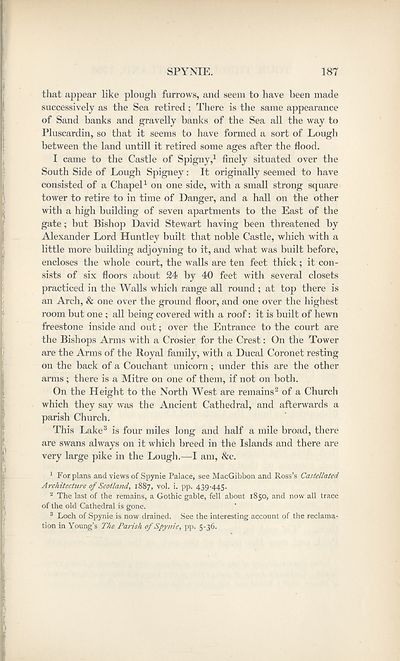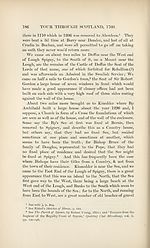Series 1 > Tours in Scotland 1747, 1750, 1760
(274) Page 187
Download files
Complete book:
Individual page:
Thumbnail gallery: Grid view | List view

SPYNIE.
187
that appear like plough furrows, and seem to have been made
successively as the Sea retired; There is the same appearance
of Sand banks and gravelly banks of the Sea all the way to
Pluscardin, so that it seems to have formed a sort of Lough
between the land untill it retired some ages after the flood.
I came to the Castle of Spigny,1 finely situated over the
South Side of Lough Spigney: It originally seemed to have
consisted of a Chapel1 on one side, with a small strong square
tower to retire to in time of Danger, and a hall on the other
with a high building of seven apartments to the East of the
gate; but Bishop David Stewart having been threatened by
Alexander Lord Huntley built that noble Castle, which with a
little more building adjoyning to it, and what was built before,
encloses the whole court, the walls are ten feet thick; it con¬
sists of six floors about 24 by 40 feet with several closets
practiced in the Walls which range all round ; at top there is
an Arch, & one over the ground floor, and one over the highest
room but one ; all being covered with a roof: it is built of hewn
freestone inside and out; over the Entrance to the court are
the Bishops Arms with a Crosier for the Crest: On the Tower
are the Arms of the Royal family, with a Ducal Coronet resting
on the back of a Couchant unicorn; under this are the other
arms; there is a Mitre on one of them, if not on both.
On the Height to the North West are remains2 of a Church
which they say was the Ancient Cathedral, and afterwards a
parish Church.
This Lake3 is four miles long and half a mile broad, there
are swans always on it which breed in the Islands and there are
very large pike in the Lough.—I am, &c.
1 For plans and views of Spynie Palace, see MacGibbon and Ross’s Castellated
Architecture of Scotland, 1887, vol. i. pp. 439-445.
2 The last of the remains, a Gothic gable, fell about 1850, and now all trace
of the old Cathedral is gone.
3 Loch of Spynie is now drained. See the interesting account of the reclama¬
tion in Young’s The Parish of Spynie, pp. 5-36.
187
that appear like plough furrows, and seem to have been made
successively as the Sea retired; There is the same appearance
of Sand banks and gravelly banks of the Sea all the way to
Pluscardin, so that it seems to have formed a sort of Lough
between the land untill it retired some ages after the flood.
I came to the Castle of Spigny,1 finely situated over the
South Side of Lough Spigney: It originally seemed to have
consisted of a Chapel1 on one side, with a small strong square
tower to retire to in time of Danger, and a hall on the other
with a high building of seven apartments to the East of the
gate; but Bishop David Stewart having been threatened by
Alexander Lord Huntley built that noble Castle, which with a
little more building adjoyning to it, and what was built before,
encloses the whole court, the walls are ten feet thick; it con¬
sists of six floors about 24 by 40 feet with several closets
practiced in the Walls which range all round ; at top there is
an Arch, & one over the ground floor, and one over the highest
room but one ; all being covered with a roof: it is built of hewn
freestone inside and out; over the Entrance to the court are
the Bishops Arms with a Crosier for the Crest: On the Tower
are the Arms of the Royal family, with a Ducal Coronet resting
on the back of a Couchant unicorn; under this are the other
arms; there is a Mitre on one of them, if not on both.
On the Height to the North West are remains2 of a Church
which they say was the Ancient Cathedral, and afterwards a
parish Church.
This Lake3 is four miles long and half a mile broad, there
are swans always on it which breed in the Islands and there are
very large pike in the Lough.—I am, &c.
1 For plans and views of Spynie Palace, see MacGibbon and Ross’s Castellated
Architecture of Scotland, 1887, vol. i. pp. 439-445.
2 The last of the remains, a Gothic gable, fell about 1850, and now all trace
of the old Cathedral is gone.
3 Loch of Spynie is now drained. See the interesting account of the reclama¬
tion in Young’s The Parish of Spynie, pp. 5-36.
Set display mode to:
![]() Universal Viewer |
Universal Viewer | ![]() Mirador |
Large image | Transcription
Mirador |
Large image | Transcription
Images and transcriptions on this page, including medium image downloads, may be used under the Creative Commons Attribution 4.0 International Licence unless otherwise stated. ![]()
| Scottish History Society volumes > Series 1 > Tours in Scotland 1747, 1750, 1760 > (274) Page 187 |
|---|
| Permanent URL | https://digital.nls.uk/126606045 |
|---|
| Attribution and copyright: |
|
|---|
| Description | Over 180 volumes, published by the Scottish History Society, containing original sources on Scotland's history and people. With a wide range of subjects, the books collectively cover all periods from the 12th to 20th centuries, and reflect changing trends in Scottish history. Sources are accompanied by scholarly interpretation, references and bibliographies. Volumes are usually published annually, and more digitised volumes will be added as they become available. |
|---|


